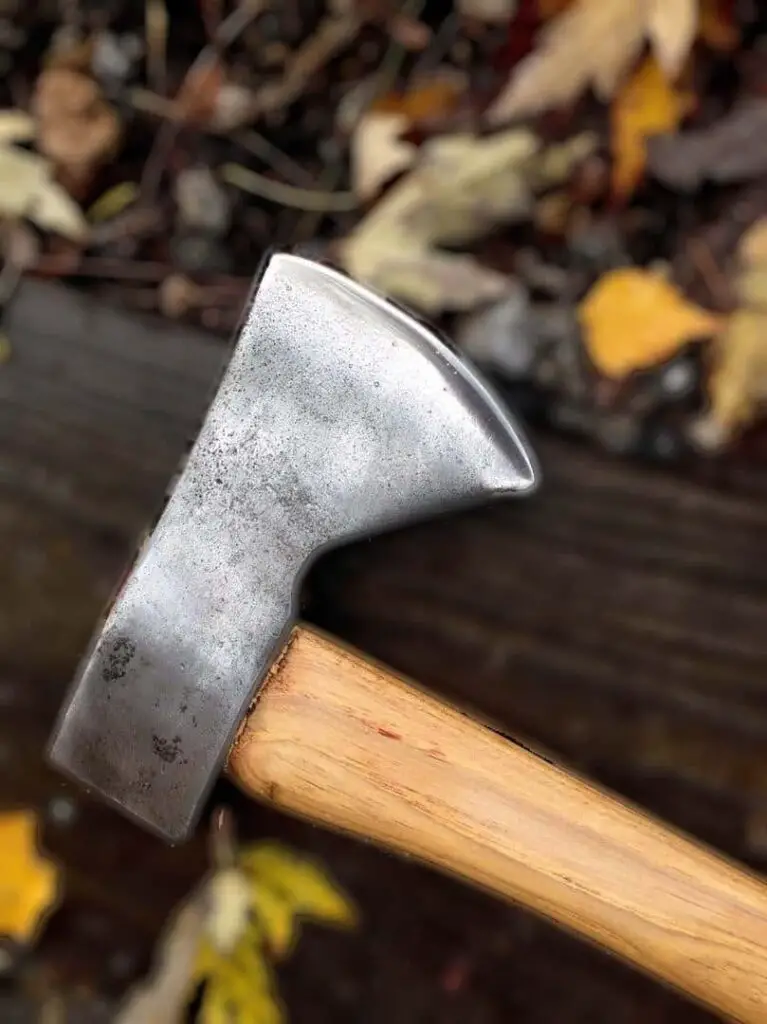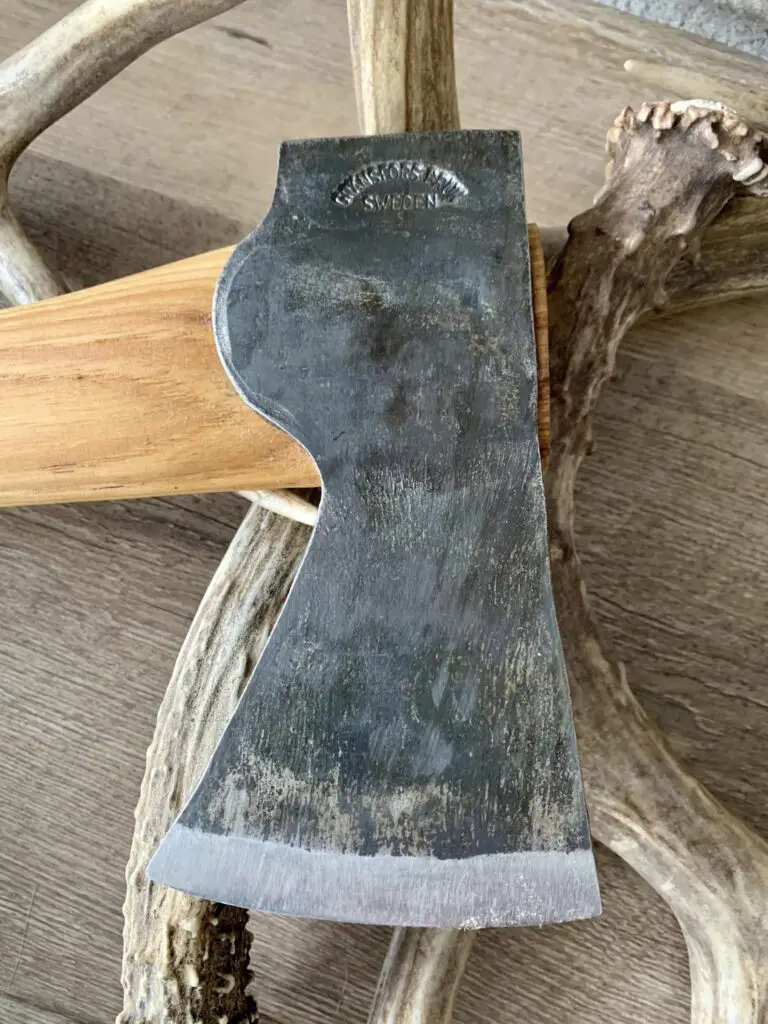The best steel for axes hinges on purpose, such as chopping, felling, or throwing. While several steels can fit the bill, carbon steel and stainless steel often come out on top due to their strength, hardness, edge retention, and resistance to wear and deterioration.
Table of Contents
What is Steel Made From?
Steel is an alloy consisting primarily of iron and carbon. However, a series of additional elements are added to customize its properties. Let’s delve into these elements, which are the secret sauce of the best steel for axes:
Carbon
Carbon is the backbone of steel. When added to iron, it acts as a hardening agent, imparting much-needed strength and hardness to the metal. This hardening characteristic is especially critical when crafting sturdy and durable axe heads. It’s the primary ingredient in carbon steel, a popular choice for axes due to its excellent balance of durability, edge retention, and ease of sharpening.
Chromium
Chromium performs multiple roles in the steel mix. It bolsters the hardness, tensile strength, and wear resistance of the steel – traits that are absolutely vital when forging a quality axe head. Chromium endows stainless steel with its corrosion-resistant qualities, making it a valuable component for axes exposed to the elements.
Cobalt
This element lends a helping hand in increasing the strength and hardness of steel, even at high temperatures. Cobalt’s heat resistance makes it an essential addition in steel used for axes meant for high-intensity work, like chopping through thick logs or felling trees.
Copper
While adding a softer metal like copper to steel may seem counterintuitive, it has a unique advantage – it significantly boosts the steel’s resistance to atmospheric corrosion. This is particularly beneficial for axes used in outdoor conditions where humidity, rain, and moisture are common.
Manganese
This element is a real powerhouse. It enhances the hardness and strength of the steel, making it more robust and suitable for rigorous tasks such as cutting or splitting wood. Manganese also makes the forging process of steel easier, facilitating the manufacture of axe heads with specific shapes and designs.
Molybdenum
When you need strength and heat resistance in steel, molybdenum steps up to the plate. It’s a valuable addition to steel used in strenuous, high-heat conditions, providing axes with the endurance they need for tough tasks.
Nickel
Nickel is the resilience-enhancer of the group. It fortifies the steel with increased toughness and resistance to impact and corrosion, creating axes that can take a beating and keep chopping.
Nitrogen
Often overlooked, nitrogen has the potential to elevate a steel’s hardness and strength. This characteristic benefits forging robust axe heads that maintain their integrity even under substantial stress.
Phosphorus
Though usually present in small amounts, phosphorus contributes to the steel’s overall strength, hardness, and corrosion resistance. This trifecta of enhancements is crucial in making a long-lasting, high-performance axe.
Silicon
A little silicon can go a long way in boosting the strength of steel. It’s a supporting player that bolsters the steel’s core attributes, ensuring the axe heads forged from it can withstand heavy use.
Sulfur
This element may not contribute directly to the axe’s performance, but it does enhance the steel’s machinability. This trait makes the steel easier to work with during manufacturing, ensuring well-crafted and high-quality axe heads.
Tungsten
Tungsten is the wear-resistance king. When added to steel, it substantially enhances its ability to resist wear and tear over time, ensuring the axe remains reliable even after extensive use.
Vanadium
Vanadium complements steel’s hardiness and wear resistance, providing an extra layer of durability. This ensures that the axe head can maintain a sharp, effective edge for a longer period, reducing the frequency of sharpening.

Qualities of Steel That Matter for Axe Heads
When picking the best steel for axes, hatchets, or any all-purpose cutting tool, it’s essential to consider the following qualities:
Hardness
The hardness of steel refers to its ability to resist deformation. When it comes to axes, harder steels have the advantage of retaining a sharp edge for a longer duration, meaning you don’t have to stop and sharpen your axe as frequently.
However, it’s a careful balance.
Harder steels can also be more brittle, making them more susceptible to chipping or breaking under extreme force or incorrect use.Selecting an axe with a hardness suitable for its intended use is essential.
Strength
In steel, strength is the metal’s ability to resist deformation under stress. This attribute is crucial for axes as they are subjected to much force during chopping, felling, or cutting tasks. A stronger steel can withstand these stresses without bending or warping, ensuring the axe remains effective and reliable.
Ductility
This property defines how much a metal can deform under tensile stress before it breaks or cracks. Steels with higher ductility can handle more impact without cracking or chipping, making them ideal for heavy-duty axe use. Ductile axes absorb the shock of each blow, making them safer and more comfortable for extended use.
Edge Retention
Edge retention refers to how long an axe blade (or any cutting tool) can remain sharp. An axe with good edge retention stays sharp longer, reducing the need for frequent sharpening and ensuring more efficient cutting or chopping. Steels with high hardness often offer excellent edge retention, but it can also be influenced by other factors, such as the heat treatment the steel undergoes.
Deterioration Resistance
Axes are often exposed to harsh conditions – moisture, dirt, temperature changes, and sometimes corrosive substances. As such, an axe’s steel must resist rust and other forms of deterioration. Steels with high deterioration resistance (like stainless steel) can withstand these conditions and maintain their integrity and performance over time.
Wear Resistance
This quality defines the steel’s ability to resist wear and tear that naturally occurs with use. It’s an essential characteristic for axes as they often endure intense use, such as chopping wood, splitting logs, or even survival tasks in the case of a camp axe. Wear-resistant axes last longer and maintain their performance and effectiveness throughout their lifetime.

What Hardness Is Best For Axe Heads?
| Rockwell Hardness | Best Suited Scenarios for Axes |
|---|---|
| 50-54 | General purpose axes for camping and wood splitting |
| 55-59 | Throwing axes, hatchets, and camp axes |
| 60-64 | Specialized axes for felling, chopping, and survival |
| 65+ | Professional or competitive axes for chopping and throwing |
Types of Steel for Axe Heads
Carbon Steel
Carbon steel is one of the most commonly used types of steel for axe heads. Its high carbon content grants it a superior hardness and strength, making it a reliable choice for axes meant for chopping and felling. The carbon content also aids in sharp edge retention over prolonged use, and the metal is easier to sharpen than other types.
In my experience, I’ve found that carbon steel axes make some of the best tools for camping and general purpose chopping. They are both durable and robust. But remember, the increased hardness can make them more prone to chipping, so they aren’t the best for rough tasks.
| Carbon Steel Type | Common Name | Carbon Content | Best Suited For |
|---|---|---|---|
| 1045 | Medium Carbon Steel | 0.45% | General-purpose axes used occasionally for splitting small logs or kindling. |
| 1050 | Medium-High Carbon Steel | 0.50% | Budget-friendly axes used regularly for camping or backyard tasks. |
| 1060 | High Carbon Steel | 0.60% | Quality axes intended for regular use in chopping and splitting. Ideal for frequent wood cutting. |
| 1070 | High Carbon Steel | 0.70% | Larger axes and felling axes for heavy use. Perfect for heavy-duty tasks and professional logging. |
| 1080 | High Carbon Steel | 0.80% | Axes designed for specific tasks requiring a very sharp, durable edge, such as competitive axe throwing or specialized wood cutting. |
Stainless Steel
Stainless steel isn’t a common choice for full-size axe heads due to its lower hardness than carbon steel. However, stainless steel can be a great choice for smaller axes and hatchets, especially those designed for camping or survival situations. Its corrosion resistance makes it an excellent choice for environments where the axe might be exposed to the elements.
I’ve owned a stainless steel camp axe for several years and can vouch for its durability and weather resistance. Its corrosion resistance is a godsend when camping in rainy or damp environments. However, they tend to dull quicker, so always have a handy sharpening tool.
Conclusion
When choosing the best steel for your axe, consider the purpose – are you going for a camp axe, a felling axe, or a throwing axe? Carbon steel, known for its hardness and edge retention, tends to be the go-to choice for many applications. On the other hand, stainless steel, while not as hard, offers excellent durability and resistance to the elements, making it suitable for camping and survival axes.
